The 17th-century Miss Poland would be not very tall, with feminine shapes, pale skin with blushes, red lips and snow-white teeth. Her waist would be narrow, her chest would be full, and her hair would preferably be pale and thick. Striving for this ideal, ladies reached for old, proven ways to correct nature.

A caricature of tying a corset. Zygmunt Wagner's watercolor painting from 1795 from the collection of the Swiss National Library (source:public domain).
The axial waist effect was achieved by wearing tight-fitting corsets, called "laces". The ladies hugged them to the point of unconsciousness! The staroste of Mszczonów, Count Eligiusz Prażmowski, during his several years' stay in France was so enchanted by French customs and fashion that he even intended to renounce his nationality . He brought with him to Poland such a strong love for French fashion that his daughter Marianna became the true martyr of the capricious and bizarre hipster and she was at home and behind the house all her life.
He imported fancy outfits for her from France and even personally laced her corset à la Pompadour, so tightly and tightly that her breasts almost reached her chin . Thanks to this, the countess gained a waist so narrow that it was said that she could be wrapped around her hands.
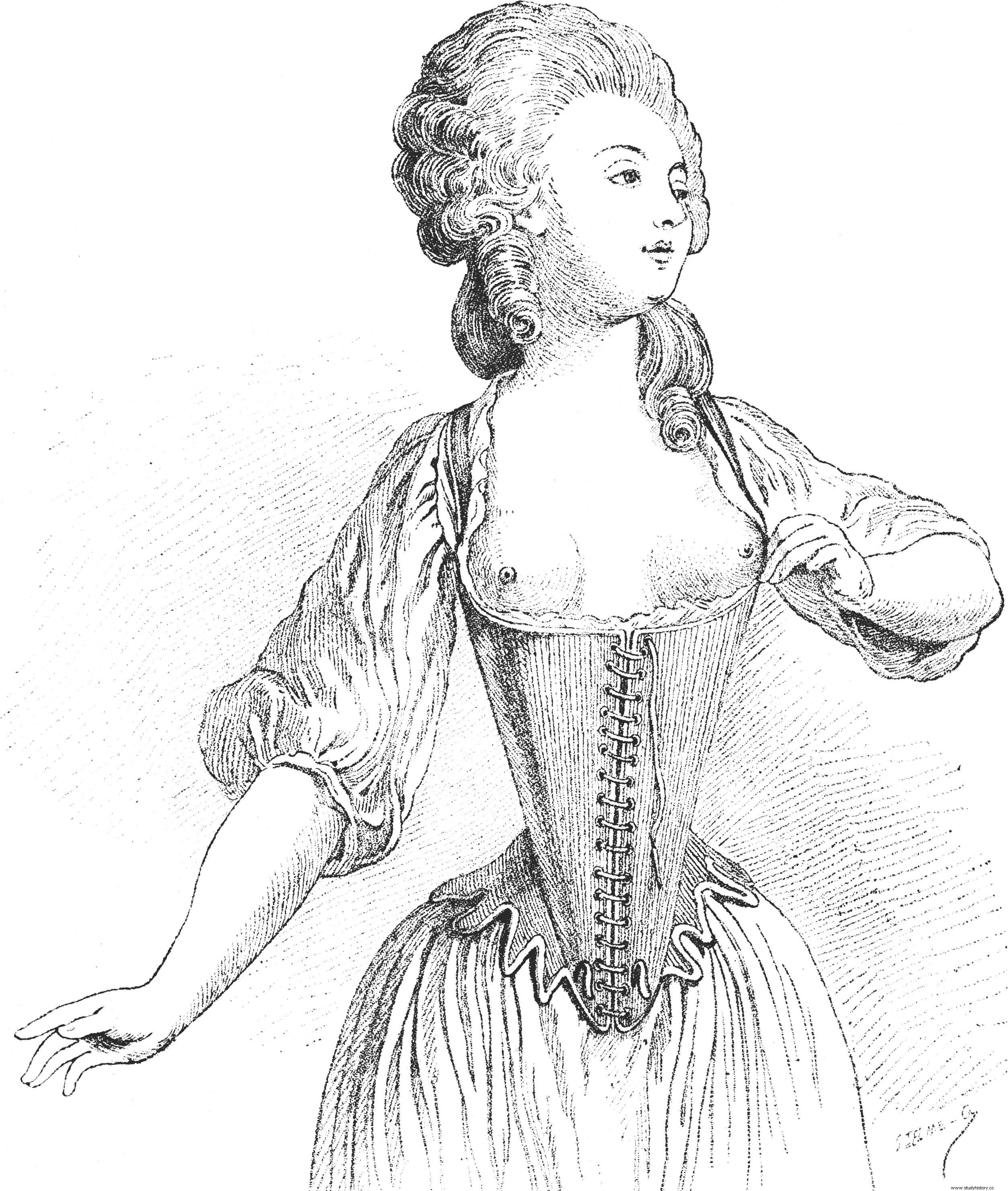
In the eyes of the scandalized Sarmatians, the women in corsets looked almost like the lady from the 18th-century "l'Essai du corset" in a drawing by de Wille (source:public domain).
The Sarmatians complained about the corsets, seeing them as the causes of scandal and moral relaxation . They were afraid that their wives, sisters and daughters would adopt other unfavorable patterns with the new fashion. The voivode, Krzysztof Opaliński, wrote in 1646: My wife is loved by the Queen, and over all other ladies, she is far from being devoured and respected and respected. She was dressed up in French for me, because she does not show her tits, although it is an alamodissimum.
The ladies, despite the bolts thrown at them, and in line with the new fashion, tried to expose even small breasts by putting pillows under the dresses. For women less generously endowed, home guides also suggested how to obtain the desired curves in various ways . In one of the works it was advised to smash the mint leaves and use it to beat the apples, they will be hard and round.
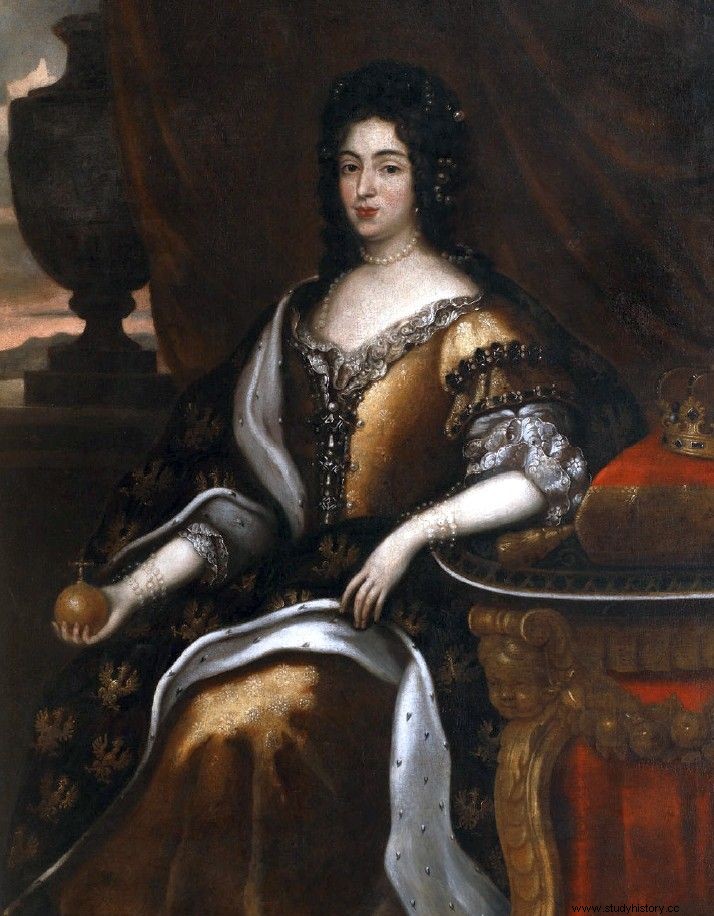
Obtaining a fair complexion with a blush like in Marysieńka's case required many sacrifices. Portrait of the Queen by Jan Tricius from 1676, on the resources of the Wilanów Palace Museum (source:public domain).
A baroque lady also had to have a perfect white sex, adorned with a blush. Since the sun was the biggest enemy of bleached skin, different specifics were used to remove the "gypsy complexion" . These treatments were carried out with the help of vodkas, ointments and oils. Szymon Syreński writes in his herbarium about a decoction, which freckles from the face [...] spends all spots, stains and hideous things [...] and wipes away.
Light complexion has long been desired by women. In her diary, Aleksandra, née Tańskich, also lamented the fate of her sister Klementyna, who was being raised by a certain old lady. I cannot give away that the most beautiful girl in the world, through carelessness, sloppily gave away a tanned, stranded lady ; barely in two years, her sex regained anything to its former state, but it lost its original whiteness and delicacy forever ... Not only the face was taken care of, but also the hands, which were supposed to be white, smooth, "brawny".
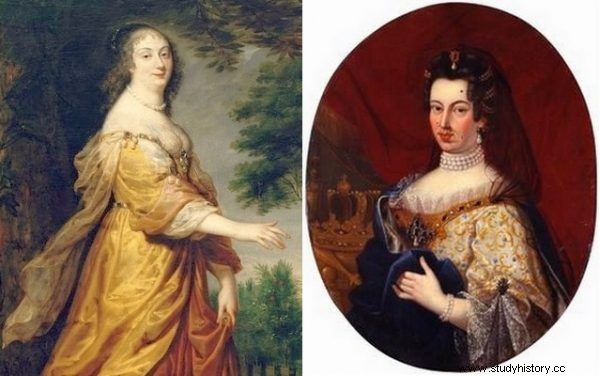
Queen Ludwika Maria (on the left in a painting by Justus von Egmont from 1645) introduced flies to Poland, but it was her goddaughter, Marysieńka Sobieska (on the right in an 18th-century portrait), who was a master of using them (source:public domain).
The effect of smoothness and the desired whiteness was achieved thanks to whitewash , i.e. powders, which were made, among others, from grated chalk and powdered egg shells. Pale complexion in the second half of the 16th century was commonly emphasized with a "dye" (prepared from various roots, saltpetre, honey, goat's milk and other additives), later called pink. Eyebrows were blackened with burnt almond powder in the oriental style, and black flies were stuck on the face, brought to Poland by Queen Ludwika Maria Gonzaga.
The meaning of the flies depended on where they were stuck:she was "in love" at the corner of her eye, "polite" on her cheek, "laughing" on her nose, "kissed" on the lip. Fashion did not spare even the young ladies:Kajetan Koźmian lamented in his diaries that Count Prażmowski forced his daughter even though she was fresh, whiten her face with paleayas, paint her eyebrows pink [...] and her face flecked with bow ties.
This article has more than one page. Please select another one below to continue reading.Attention! You are not on the first page of the article. If you want to read from the beginning click here.
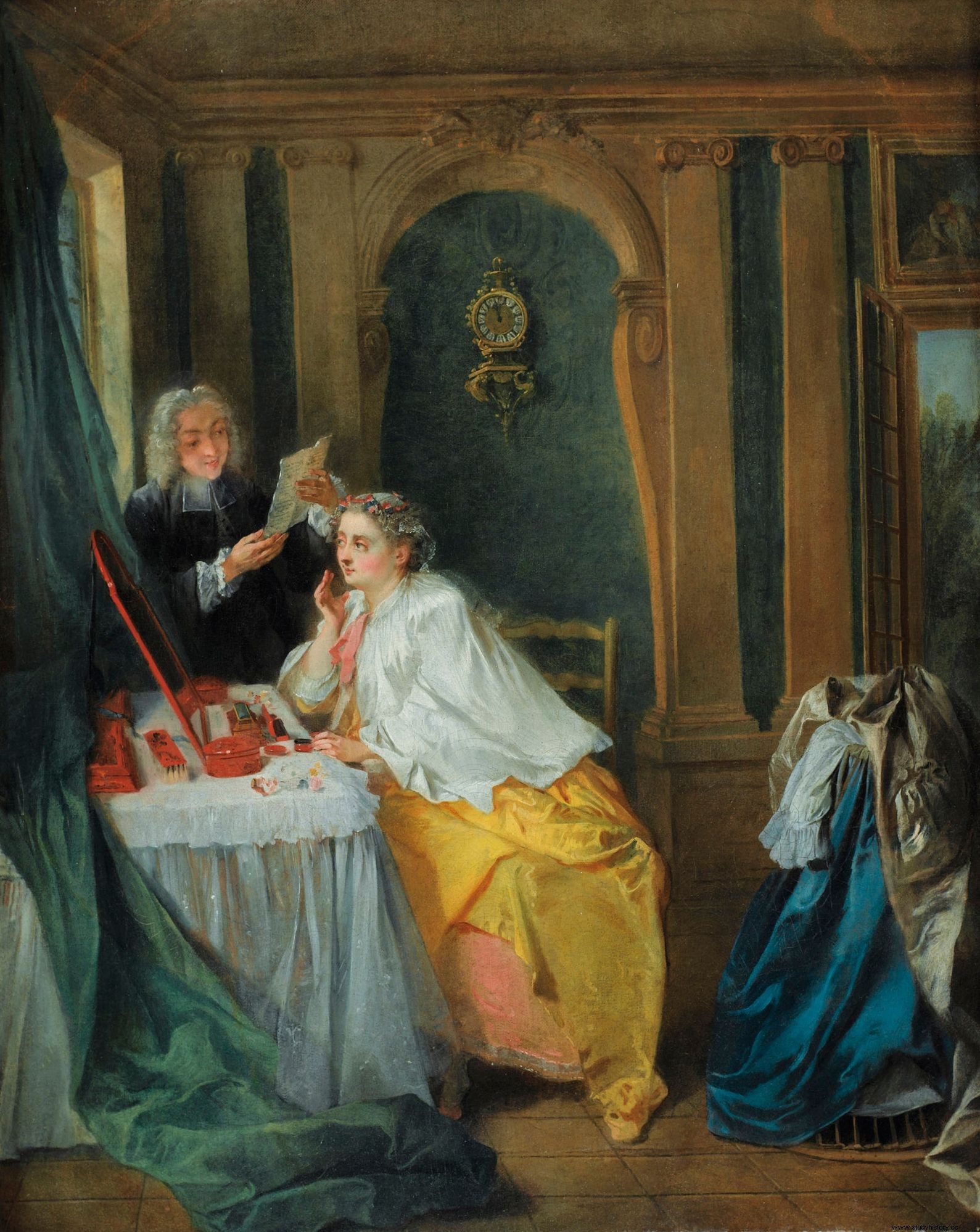
Whitewashed? Blackened? Reds? Or maybe bluefinish? What to use today to look divine? Painting by Nicolas Lancret from 1732 (photo:the lost gallery, flickr, lic. CC BY 2.0).
An old Polish proverb said that will not help a blansz than a pink when the old lady is already , but each tried her best to correct the imperfections. Ignacy Krasicki in "Pan Podstolim" mentioned how whitewash, blackthorn, reddish and bluefin can be used, how to enliven the eye with reddish, enlarge eyebrows with blackened, use whitewash to improve the sex, use the blue color to mark the course of delicate veins.
Jan Kochanowski ridiculed this exaggeration, because it was impossible to judge the real beauty of the adored lady : I often equaled her sex to a ruddy blush, And she wore a delicate color on her face. Interestingly, not only women but also men were chasing western fashion.
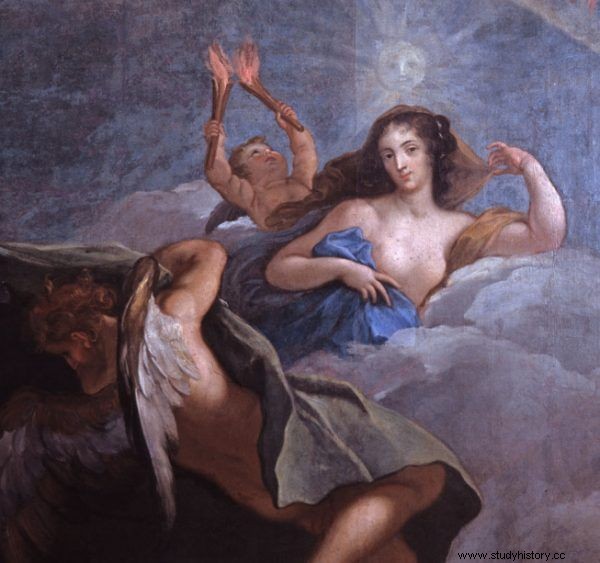
Marysieńka's beautiful long hair, wonderfully curled, we can admire, for example, in this painting by Jerzy Siemiginowski-Eleuter from 1685, which shows the queen as Dawn (source:public domain).
Kajetan Koźmian lamented: Not only the capital, but also other provinces were full of this kind of exaggerated elegant men, when I recall [...] Rzewuski, the Grand Marshal of the Crown, a minister who wasted half a day on styling his hair in [...] and whose butlers filled the entire office with fragrant powder so that it would slowly settle on his hairstyle. Rzewuski was said to take care of his complexion by sleeping in compresses made of… slices of fresh veal.
An intricate hairdo completed the appearance of each Sarmatian beauty. Until the second half of the 17th century, brides wore long hair, and married women cut their braids and put on a bonnet. When the caps were no longer used, more and more attention was paid to hairstyles - the ladies started to "tickle" their hair, that is, to arrange it in curls, twisted in curls or pinned up, as we can see today in the portraits of Marysieńka Sobieska.
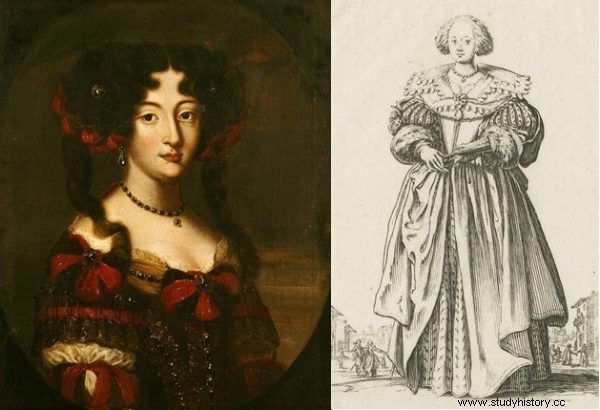
The high forehead was fashionable. We see them both in Marysieńka (portrayed by Jacob-Ferdinand Voet) and in the 17th-century Lorraine lady (in the drawing by Callot Jacques), whose appearance is almost grotesque to us (source:public domain).
At the beginning of the 17th century, ladies torn the strands above their foreheads high foreheads were fashionable. The poet Sebastian Fabian Klonowic mocked such bald, muscled and colored wives but the fashion held tight. The remaining hair had to be thick and healthy, which could be ensured by washing the strands in rainwater or in… washes.
hair dye was also in vogue :blondes darkened them (for example, with nut extract), and browns - lightened them (with an ointment containing celidonia root, cumin, olive oil and other additives). The gray hair was masked by blackening the hair with a lead comb , soot, sage juice, or "drank with lye."
This article has more than one page. Please select another one below to continue reading.Attention! You are not on the first page of the article. If you want to read from the beginning click here.
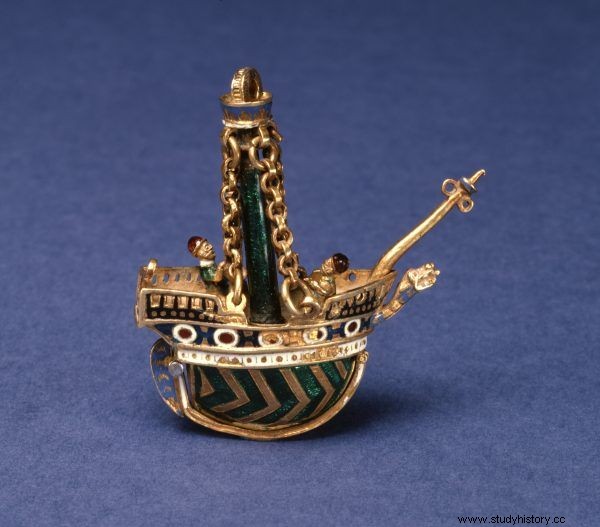
A tempting scent is part of the baroque image that should accompany every fashionable lady. The photo shows a ship-shaped pomander from the first half of the 17th century (photo:Walters Art Museum, license CC BY-SA 3.0).
Sarmatian customs did not convince themselves of perfumes for a long time. Only rose water did not raise any objections, sometimes fragrant vodkas or oils were used, but perfumes were a luxury reserved for some court circles and wealthy nobility . They were usually worn around the neck closed in the form of so-called pomanders, and the promoters of this fashion were mainly men.
They were prepared from aromatic substances, plant powders, roots, flowers, gum-resins, etc. The composition also included ambergris, cybet and musk. Piotr Skarga mentioned in one of his sermons a box with musk and a graceful scent whatever you bring to it, all with this musk fragrance . To this day, a beautiful pearl vessel for such fragrances hangs in the lower part of the ruby dress of the Częstochowa Maki Bosnia. They were offered in the 30s of the 18th century by Mrs. Ponińska, the castellan of Poznań.
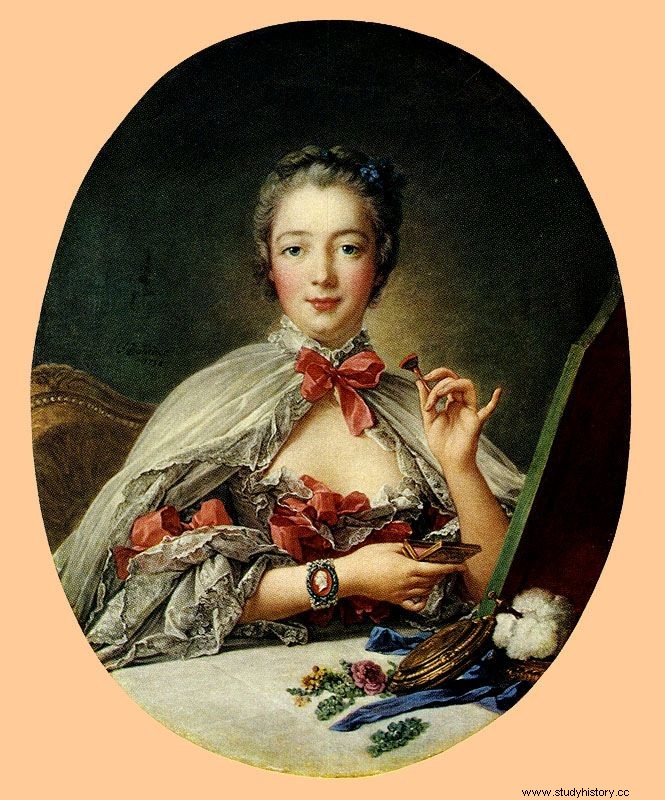
In slightly later times, Polish elegant ladies modeled themselves on Madame de Pompadour. Painting by François Boucher from 1758 (source:public domain).
Fashion for improving beauty, as well as all the novelties, came to the ladies of the Sarmatian era from Western countries. Young brides and married women going abroad, often to improve their health, brought political and social gossip, as well as fashion news to the country. . In their travel trunks they carried the latest types of à la Pompadour corsets, wigs and wonderful creams.
These novelties had to be used immediately and passed on to friends, because it was this that made it possible to distinguish a real worldly, sophisticated lady from just any plebeian . And that sometimes on a walk there was a city bully who blew such a beauty in the face with petals of carnations that stuck to the "smeared" face, arousing laughter of passers-by? Well, that's hard. That was the price of perfection.
Inspiration:
The gallery was inspired by the images of beautiful Sarmatians from the novel by Robert Fotys, Hetman's Gambit, (Open edition 2016).
Bibliography:
- Bystroń, J.S., History of customs in old Poland. XVI-XVIII centuries, Trzaska, Evert and Michalski, Warsaw 1933
- Kitowicz, J., Description of customs during the reign of Augustus III, National Institute Ossoliński, Wrocław 2003
- Kuchowicz, Z. , Old Polish customs in the 17th and 18th centuries, Łódź Publishing House, Łódź 1977
- Lisak, A., Old Polish love. Manners, intrigues, scandals, Bellona Warsaw 2011
